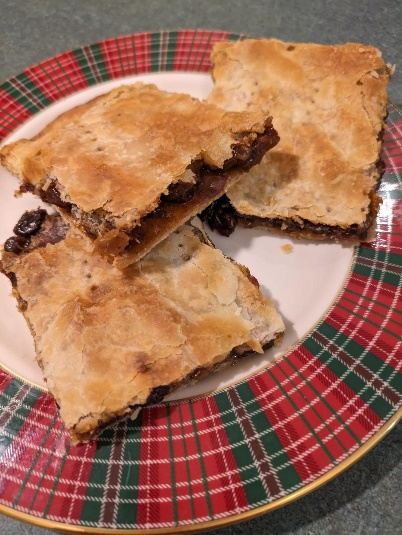
By Carolyn Graf
It’s said that raisins were discovered when humans stumbled into some grapes drying on a vine. History books record that raisins were sun-dried from grapes as long ago as 1490 B.C. Several hundred years passed before it was determined which variety of grape would make the best raisin.
Sometime between 120 and 900 B.C., practical ways were developed to grow grapes to become raisins. During that time, Phoenicians started vineyards in Greece and southern Spain, and Armenians created vineyards in Persia — now Turkey, Iran, and Iraq. These areas not only had ideal climates for growing the fruit, they were also close to the first commercial markets for raisins — Greece and Rome.
The raisin became a favorite fruit of the Greeks and Romans, who used them for everything — from adorning their places of worship, to honoring winners of sporting contests. Roman doctors prescribed raisins to cure anything from mushroom poisoning to old age.
With their growing appeal, raisins increased in value. Two jars of raisins could be traded for one slave in ancient Rome.
The fruit became popular among warriors of the time. Emperor Augustus feasted on small roasted birds stuffed with raisins. Hannibal stored raisins for his crossing of the Alps.
Spain’s Queen Isabella sent missionaries to Mexico to teach natives about religion. Among the things the missionaries passed on to the people was their knowledge of grapes — viticulture.
Moving into California, the missionaries found excellent growing conditions and a long, hot growing season in the San Joaquin Valley. Although only 10 inches of rain falls on this area each year, an extensive irrigation system — constructed over a century ago — brings water from the Sierra Nevada, creating one of the most fertile valleys in the world.
California’s first raisin crop was grown by nature, not farmers. In September of 1873, a massive heat wave hit the San Joaquin Valley just before harvest. Most of the grapes dried on the vine before farmers could pick them. Not willing to throw his crop away, one farmer took his raisins to San Francisco, where he found a grocer who agreed to sell the fruit, which was unfamiliar to many customers. Raisins soon became popular enough that a sizable market was created.
At that time, muscat raisins were favored. They were oversize with seeds and full of flavor, but they were messy. If consumers wanted to use them for baking, they first needed to force the seed through the skin by hand.
In 1876, Scottish immigrant William Thompson found the perfect grape for raisin farmers. He grew a seedless variety of grape called Lady deCoverly, which was thin-skinned, seedless, and sweet. When sun-dried, these grapes became the dark raisin popular today, and with special processing they became the lighter golden raisins. Today, 95 percent of California raisins are made from Thompson seedless grapes grown in the San Joaquin Valley.
Raisins in Scotland
There are several vineyards in Scotland, but the climate is not really favorable for growing grapes. Nevertheless, raisins have been popular in Scottish recipes for hundreds of years. One tradition involving raisins happens every November at St. Andrews University during Raisin Week. Freshman students are “adopted” by upper classmen whom they call “Mum” and “Dad”. Academic parents have an important role in helping students to integrate into life in St Andrews, and meeting new people in different years.
On Raisin Sunday it is traditional for students to go round to their mother’s for a “tea party”. This may involve lots of alcohol instead of tea, and silly party games. Children receive ‘raisin strings’ which are strings with a personal gift attached. After the tea party is over children head over to their fathers for more drinking.
The tradition was that children were expected to give their parents a pound of raisins. Raisins were more valuable and rarer in the past. Some sources claim that the tradition of a pound of raisins started with students giving their mothers raisins as a thank you for the festivities. However as women were only admitted to St Andrews in 1876, it is likely that much of the tradition in its modern form dates from a later time. In the modern-day version, parents more often receive a different grape-based product called wine.
The following day is ‘Raisin Monday’ and the children are required to get up and collect their ‘raisin receipts’ from their fathers. Traditionally raisin receipts were pieces of parchment with a message in Latin ascribed on them. More recently, the tradition has been to provide children with something difficult and embarrassing to carry. Mothers dress their children up in costume. Once in costume children are marched to St. Salvators Quad on North Street to take part in a shaving foam fight between 11 am and 12 noon.
It is claimed the tradition of Raisin Monday dates back to the very beginnings of the University in 1413, although the foam fight certainly seems to be a more recent addition with obscure origins.
https://owlcation.com/academia/St-Andrews-University-traditions
Fly Cemeteries Raisin Recipe

The name of this pastry goes back at least a hundred years where it is mentioned in letters and diaries. Variations on the fly/bug theme abound: Fly Graveyard and Squashed Bug Slice. As Scots traveled, so did their recipes. Many references were found from New Zealand to California but all credit Scottish ancestors for the recipe. Drying fruits to preserve them is a very ancient custom so the pastry is probably older than the humorous name for it.
Pastry:
1 ½ cup all-purpose flour
Pinch of salt
6 tablespoons of cold butter (original recipes called for lard)
A little ice water
Put the flour and salt in a mixing bowl. Cut in the butter, using a pastry blender or by criss-crossing two knives. The mixture should resemble corn meal. Quickly add enough water to make a stiff dough. Mix only until just combined. Over-mixing will result in tough pastry. Divide the dough in half, wrap in plastic and put in refrigerator.
Filling:
½ cup dark raisins
½ cup golden raisins
½ cup currents (or any variation of this combination. I used dark raisins.)
1 cup water
1 teaspoon mixed spices (crushed coriander, ground cinnamon, ground cloves, ground allspice, ground nutmeg, ground ginger. Again, choose your own combination.)
2 tablespoons sugar
2 tablespoons flour
Preheat oven to 425° F. Mix the flour with a little of the water. Put all other ingredients into a saucepan; stir in the flour/water mixture. Heat gently for a while to soften the fruit. (Some recipes recommend soaking the fruit overnight. This might be good if you have very hard fruit or if you want your fruit to be very soft. I didn’t.)
Roll out half the dough in a greased and floured jelly roll pan. Spread the fruit mixture over the pastry, leaving a small bit of clean pastry around the edges. Brush the edges with a little milk.
Roll out the other half of the pastry and place over the fruit mixture. Press down the edges to seal. Poke holes in a few places with a fork, brush with a little milk, and bake 30 to 40 minutes until golden brown. Sprinkle with a little sugar while still hot and let cool. Cut into square slices to serve.
One recipe also included apples and cranberries. Perhaps then it would just be a Fruit Slice instead of a Fly Cemetery.
This version of Fly Cemeteries is from Quick and Easy Scottish-American Recipes.

